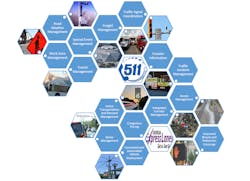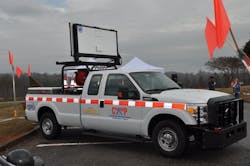How TSMO Facilitates Successful Transportation Systems
For most people, transportation is like any other constant in life—an abstract function that people are generally absent-minded about because they simply trust that everything will go as it should. But, in actuality, it is not that simple.
A broad range of innovations—from the traffic signal to unmanned aircraft systems (UAS)—have emerged that enable agencies and practitioners to better operate the nation’s transportation systems. However, only recently have transportation agencies begun to take a comprehensive and strategic view of deploying and using these strategies. The coordinated effort is known as transportation systems management and operations (TSMO) strategies.
What is TSMO?
According to the U.S. DOT, TSMO is an integrated set of strategies designed to optimize the performance of existing infrastructure through the implementation of multimodal and intermodal, cross-jurisdictional systems, services, and projects. These strategies are set to preserve capacity and improve security, safety, and reliability of the transportation system.
TSMO is the programmatic and cultural response to inefficiencies in transportation management. Integration and coordination between strategies helps to facilitate seamless coordination during emergencies or major events by developing and maintaining collaborative relationships across agencies and jurisdictions. TSMO also allows agencies to be good stewards of existing transportation infrastructure, while encouraging and enabling innovation and advancement that reinforces safer, more efficient transportation systems.
TSMO is not a new concept
Though TSMO incorporates new ideology based on preparing for the future of transportation, the essence of the concept—optimization and management—is nothing new.
As early as the 1930s, the American Association of State Highway Officials (AASHO), inspired by congestion on streets, introduced U.S. numbered highways, and the first national standard for signs, markings, signals, and other traffic control devices—known as the Manual on Uniform Traffic Control Devices (MUTCD).
Since the 1930s, the traffic engineering industry has worked to integrate different strategies, with programs named TOPICS (in the 1960s and ‘70s) and TSM (in the 1980s), as new influences and developments occurred.
Since the early 2000s, these strategies, which increasingly incorporate both incident management, vehicular automation, and the interaction between the infrastructure and vehicles have become known as TSMO.
Why does TSMO still feel so foreign?
Many transportation agencies feel they are already doing what TSMO proposes, but it is not necessarily about doing something different; it is about a comprehensive assessment of candidate TSMO strategies.
In addition, TSMO strategies, like traffic signal retiming, or maintenance of traffic signals and other technologies, are frequently invisible to the public. In the case of the signals, drivers do not see the changes, but experience them through quicker travel times and reduced numbers of stops at traffic signals. This lack of visibility can cause challenges in communicating the effort undertaken and its benefits. The graphic below shows the elements of TSMO—areas transportation agencies are already managing yet may not be integrating into a comprehensive TSMO strategy.
Another challenge faced by agencies adopting the TSMO approach is a change in agency culture. In order to maximize the potential of TSMO, agencies must develop a workforce that values and prioritizes the use of TSMO solutions across multiple disciplines. The culture of any agency is something that develops over many years—and it is entirely likely that an agency of substantial size (like state transportation agencies) may have several existing cultures within. Shifting a culture that took years to develop inevitably presents reticence and at times resistance, challenging the focus and prioritization of TSMO.
TSMO success stories
Awareness of past successes can help TSMO adoption. The integration required to successfully implement TSMO strategies can be seen in the following, drawn from recent Georgia experiences.
I-85 Rebuild
Just two years ago, Atlanta experienced a crisis that significantly impacted a major route into and out of the city of Atlanta. In 2017, the bridge on I-85 northbound over Piedmont Road collapsed due to an intentional fire set under the bridge. Thankfully, there were no injuries to motorists or first responders, but this had a major impact on metro Atlanta traffic as I-85 is a major connector for commuters, as well as a significant freight route.
With more than 243,000 vehicles traveling this major route daily, Georgia DOT (GDOT) and its contractor partner worked non-stop to rebuild and replace the 700-ft section of roadway and to reopen the corridor quickly and safely. In total, 13 million lb of debris were removed and 13 columns, 61 beams, and four caps were replaced. Overall, 54,000 hours of manpower went into the construction resulting in a completion date five weeks ahead of schedule—only 42 days after the fire, which generated an estimated $27 million savings for motorists.
The department’s extensive and innovative use of TSMO strategies helped to manage the diversion of the tremendous volume of traffic. The department implemented new traffic signal timing plans managed by its state-of-the-art signal timing system, temporary modifications to lane configuration and striping, leveraged existing CCTV camera coverage, incorporated dynamic message signage (both permanent and portable), and expanded use of HERO resources—the state’s Highway Emergency Response Operators program. Thanks to the heroic efforts of the department and its contractor partner, the GDOT was able to restore the bridge just six weeks after the March 30 incident and successfully manage traffic demands in the interim.
Super Bowl LIII
Hosting the Super Bowl in February 2019 was most certainly a “major deal” for the state of Georgia. But it was also the culmination of a TSMO-focused effort that began prior to the opening of the Mercedes-Benz Stadium in August 2017.
Developing relationships with traffic management staff between agencies, as well as building relationships with law enforcement, were key to the remarkable traffic management success associated with the Super Bowl. Starting with the first event at the new stadium, to the first football game, to the College Football Championship game in 2018, and then to the Super Bowl in 2019, relationships and trust were built so traffic over the entire Super Bowl week was managed without any law enforcement directing traffic in the street, as was typically the norm.
Key to this success was the Regional Traffic Operations Program (RTOP), an innovative arterial traffic management program which dedicates signal timing and maintenance staff to critical arterials in the metro Atlanta region. The programs demonstrated success provided considerable trust between stakeholders that continued to prove its worth during the Super Bowl.
In preparing for Super Bowl LIII, GDOT anticipated all eventualities—including inclement weather. Early February is typically peak winter weather season for north Georgia, so preparations ensured adequate equipment, material, and manpower to respond to such an event and maintain the activities associated with the game.
Attendance across Super Bowl LIVE and Super Bowl Experience topped 500,000. The Transportation Security Administration (TSA) screened a record number of Hartsfield-Jackson International Airport passengers in one day, with 101,999 passengers screened on Feb. 4, 2019, the day after the event. There were 1,593 private jet arrivals at other Atlanta-area airports and MARTA, Atlanta’s public transportation rail and bus network, ran for 94 hours straight, transporting more than 500,000 people throughout Super Bowl weekend.
HERO & CHAMP
Incident management is a critical strategy to restoring lost capacity on frequently congested major roadways. A prominent and very popular example of this is Georgia’s Highway Emergency Response Operators (HERO) program and the Coordinated Highway Assistance & Maintenance Program (CHAMP). By simply calling 511, motorists on metro Atlanta interstates can request a HERO dispatch for traffic-related incidents or immediate roadside assistance. Outside metro Atlanta on other interstates throughout the state, the public can request a CHAMP.
This free service helps to quickly restore normal traffic flow by safely clearing roads in the event of an emergency or unexpected incident. HERO's primary purpose is to minimize traffic congestion by clearing wrecked or disabled vehicles from the travel lanes and providing traffic control at incident scenes. As a secondary service, HERO operates as a service patrol: assisting stranded motorists who often have a flat tire, are out of fuel, or stranded by a mechanical failure of their vehicle. In addition to normal patrol duties in metro Atlanta, HERO—staffed by GDOT employees—is deployed to assist with traffic control during major events such as the Masters Tournament in Augusta, Georgia and hurricane evacuations along Interstates 16, 75, and 95.
HERO has 110 active operators; monitors 31 routes in metro Atlanta, patrols 400 miles in metro Atlanta, and assisted 111,600 motorists in 2018.
When considering expanding its incident management services statewide, GDOT referenced a national survey of major metro areas and other southern states such as Tennessee and Florida about their use of contracted highway safety patrols. Data from that survey and local research helped the department plan for a similar statewide service. In 2016, GDOT deployed the Coordinated Highway Assistance and Maintenance Program (CHAMP) to cover interstates outside of metro Atlanta. CHAMP is integral to the department’s TSMO program.
CHAMP has:
- 57 operators, 24 full time dispatchers, 4 managers and 3 supervisors
- Monitors 20 interstate routes outside metro Atlanta in Georgia
- Patrols an average 51-mile section of the interstate
- Assists an average of 12,000 motorists a month
TSMO is not a trend, it’s here to stay
Additional strategies are evidence of the need and value of an organized and systematic approach to TSMO planning. Some of those strategies include integrated corridor management (ICM), active transportation and demand management (ATDM), connected vehicles (CV), and cooperative automated transportation (CAT).
Transportation agencies must develop policies and regulations that address the new dynamic brought on by integrating increasingly automated vehicles on the existing road network. Georgia’s TSMO organization is at the forefront of both implementing connected vehicle technology at over 1,600 of its critical traffic signals and initiating discussions with the automaking industry to help shape the interaction between these automated vehicles and the infrastructure which GDOT operates and maintains.
TSMO strategies are increasingly at the forefront of transportation agencies’ responses. But TSMO strategies continue to change and evolve, as technologies continue to advance and experiences with various strategies mature. This demands a flexible, capable workforce that may require skill sets not typically found in public sector transportation agencies. This is a separate, but obviously related, discussion within TSMO, its strategies, and its successes as the program continues to evolve.




